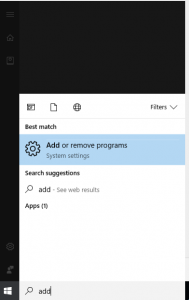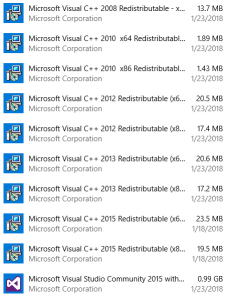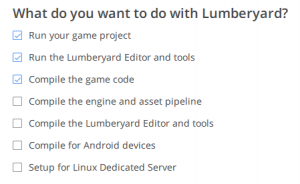Installation
Installation and Setup
Lumberyard is available as an installer for the Windows platform only. You can find the system requirements here. The setup comes with three modules:
- The Setup Assistant that lets you configure your installation.
- The Project Configurator that lets you create and configure projects, enable/disable gems, as well as select the project you want to work on in the Editor.
- The Editor where you actually create your game.
The game engine offers two types of installation options – Express and Custom. Express Install only does the basic installation that allows you to open up the Editor and work on and run the sample projects provided with the engine. Custom Install on the other hand allows you to do more with the engine by letting you select your installation options as per your needs. For any kind of development outside on a project of your own, you will need to follow this option. We will be walking through the custom installation process below.
Uninstalling Visual Studio
Lumberyard uses Visual Studio to build and run the engine and game code. You would need to install a compatible version of the IDE (details below). One of the major problems we faced during the installation process was having incompatible versions of Visual Studio installed alongside the one that Lumberyard wanted. We ran into errors despite having all the required software and SDKs, so we decided that the best solution was to get rid of incompatible versions of Visual Studio. Usually these errors would not appear in the engine compilation process, but rather during the project creation process. in the Project Configurator. We found that, in general, if your project creation fails, it is likely an issue related to Visual Studio.
- Uninstall all previous versions of Visual Studio along with the redistributables.
- Click on the start menu search bar and type “add remove”. Select Add or Remove Programs.

Add or remove programs setting - In the window that opens up, scroll down to “M” and delete all versions of Microsoft Visual Studio along with the Redistributables. Please ensure that you don’t delete the Visual Studio Installer before uninstalling the application itself. Your computer might need to restart during the process.

Visual Studio redistributables
Uninstalling Wwise
Audiokinetic Wwise (Wave Works Interactive Sound Engine) is the only software that Lumberyard supports to add sounds to your game project. Lumberyard comes packed with a free version of Wwise that you can use out of the box. If you have a license for a later version of Wwise available and want to use that, you can skip this step and refer to Lumberyard’s documentation on using your version of Wwise instead. However, we found that our installation had some incompatibilities. We found this issue to be a general trend. Lumberyard requires installing specific versions of software in specific ways. While there might be existing solutions to these problems, for the sake of simplicity, we decided to uninstall conflicting software and reinstall them through Lumberyard’s Setup Assistant.
- Click on the start menu search bar again and search for “wwise”. If you see the Wwise Launcher, right click and select Run as Administrator. If you don’t have Wwise installed on your computer, skip to the next step.
- In the Wwise launcher, look for the current installation in the tabs on the top and uninstall all versions of Wwise.
- Go to Add or Remove Programs again, look for the Wwise launcher, and uninstall it.
Installing Lumberyard along with its dependencies
This step will walk you through the steps required to actually install and build the engine.
- Open up the Lumberyard Setup Assistant.
- Click on the first three check boxes. The tabs on the left will turn red to signify missing software and/or SDKs.

Lumberyard Setup Assistant getting started - Follow the instructions on individual tabs and install all the required SDKs and software.
- For Visual Studio, sign in to your Microsoft account when prompted (CMU students can use there Andrew accounts for a student license) and download Visual Studio Community 2015 with Update 3 or the version specified by the latest installation of Lumberyard. When you open the installer, click on Custom and check the following before installing:
Programming Languages -> Visual C++ -> Common Tools for Visual C++ 2011
Programming Languages -> Visual C++ -> Microsoft Foundation Classes for C++ - In the “Install software” tab on the Lumberyard Setup Assistant, also install the Audiokinetic Wwise LTX Authoring Tool that’s listed under “Optional Software”.
- For Visual Studio, sign in to your Microsoft account when prompted (CMU students can use there Andrew accounts for a student license) and download Visual Studio Community 2015 with Update 3 or the version specified by the latest installation of Lumberyard. When you open the installer, click on Custom and check the following before installing:
- Before you proceed, make sure your system locale is set to English (United States).
- Navigate to: Control Panel -> Clock, Language, and Region -> Region
- Click on the Administrative tab.
- Change the system locale settings to English (United States).
- You might need to restart your computer after this.
- Open the Command Prompt by searching for “cmd” in the search bar.
- Navigate to the dev folder in your Lumberyard installation director. Typically you can do this through this command:
> cd C:\Amazon\Lumberyard\1.12.0.1\dev - Run the following two configuration commands:
> lmbr_waf configure
> lmbr_waf build_win_x64_vs2015_profile -p game - Important Note: In general, every time you add/remove gems from a project you create, or make any changes to the C++ code, you will have to run the above two commands. These commands will only work for the project that is set as default in the Project Configurator. You will have to repeat the steps for another project by first setting it as default in the Configurator and then running these commands. It is also required that your Lumberyard Editor is not open. The commands will fail with unhelpful error messages if your Editor window is open.
- Navigate to the dev folder in your Lumberyard installation director. Typically you can do this through this command:
- Finally, ensure your setup was done correctly by opening up the Lumberyard Project Configurator and creating a new project.
First Time Launch
Lumberyard comes prepackaged with a few sample projects that act as a great reference for developers to get started with creating their own games using the engine. Starter Game and Samples Project each contain sample levels and the Getting Started Guide video tutorial series goes hand-in-hand with these samples. Since Lumberyard currently doesn’t have any publicly available “Asset Store” of any sort, these projects also serve as a great asset-rich resources that you can use.